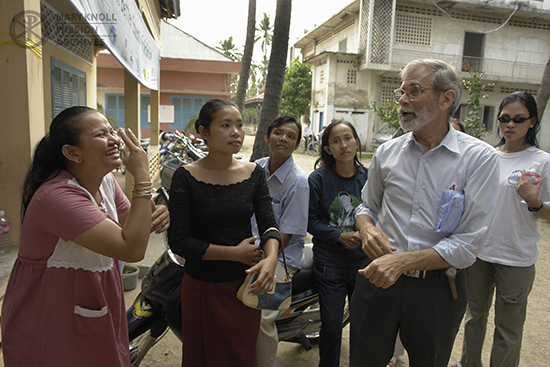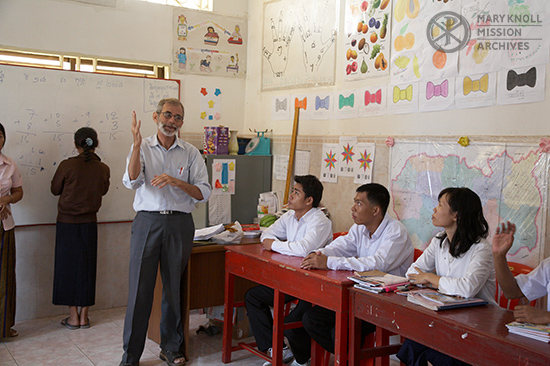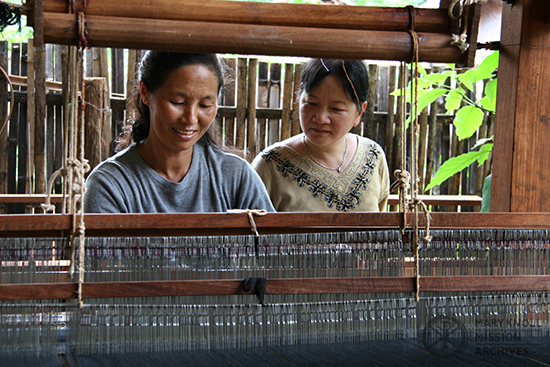Cambodia
The Deaf Development Program was begun by a young deaf woman from Finland, sent to Cambodia by the Finnish Association of the Deaf in 1996 to assess the situation of the deaf community there. She began locating deaf people and informally bringing them together. In this work, she was assisted by a list of deaf people that had been created at the prompting of Maryknoll Father Jim Noonan. Working with her was Judy Saumweber, a Maryknoll Lay Missioner who was advising the Cambodian Disabled People’s Organization (CDPO).
With funding from the Finish Association of the Deaf, the Deaf Development Program teaches basic literacy, simple mathematics, and sign language to the deaf people in Phnom Penh and four provinces (Banteay Meanchey, Kampong Speu, Kampot, and Svay Rieng) where the Cambodian Disabled People’s Organization had branch offices.
In 2001, Fr. Charlie Dittmeier, an Associate Priest with the Maryknoll Lay Missioners became an advisor to the Program at CDPO. However, during that time the CDPO’s deaf program dissolved and Maryknoll stepped in to keep the Program alive.
Today, “the program offers sign language, education, vocational training, and basic life skills to deaf individuals. Besides efforts to promote a national sign language, the program fosters leadership skills and the establishment of deaf organizations in various areas. It has three community centers for students and members of the deaf community to participate in social activities, sports, and adult education.” [Taken from Fr. Charlie Dittmeier’s profile on the Maryknoll Lay Missioner’s website].
Thailand
The goal of this project was to assist the Kachin refuges to become economically self-sustainable and obtain some form of identity to begin a new life in Thailand.
There were numerous projects within the Village that the Lay Missioners were involved with:
- Women’s Handicraft Project: Approximately, 15 women were involved in making, teaching, developing, and learning handicrafts. Crafts included weaving, doll making, and sewing and the types of items created included dolls, bags, wall hangings, purses, hand towels, and shirts and pants. The women were then able to sell the items to various tour groups that come through the village.
- Daycare Ministry: Local women were employed in this project as teachers at the daycare. The children learned songs, dances, the Thai and English alphabet, and counting. For many children this provided stability and security in a loving and caring environment.
- Outreach to Orphaned Children and Recent Refugees: This was the first aspect of the Kachin Refugee Village. It provided school fees and uniform/supplies for children in the village, emergency assistance (food and clothing) to newly arrived families, and paid for hospital expenses.
Tawny detailed her time at the refugee village in her newsletters. Here is an entry from October 2003:
“We are sitting on the balcony of the thatch-roofed house in Baan Mai Samakhii, a Kachin Refugee village. The open steel pipe was built a few months back; it runs along the roof to capture the rainwater and lead it down to a big clay tank. The tank is always full of water during the rainy season. We thank God for the rainwater; the villagers do not have to go too far to fetch water. The garden is always green with all sorts of vegetables to eat.”
In December 2003, Tawny writes:
“The Kachin refugees [are] rejoicing because we just provided a machine that produces bamboo stripes for them to make cabbage baskets…Learning to weave baskets gives them another occupation that they can rely on during the dry season. They can sell each basket for 3 baht (about 8 cents). After a while, they can weave faster and earn as much as for a day working on the farm: 100 baht ($2.50).”
All photographs by Sean Sprague.






